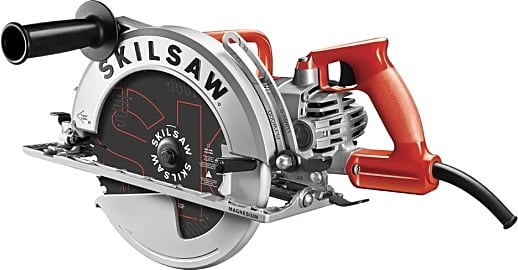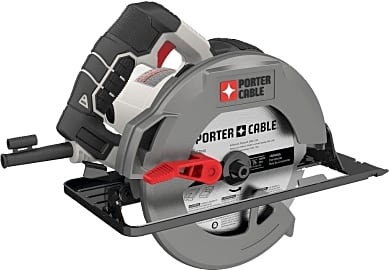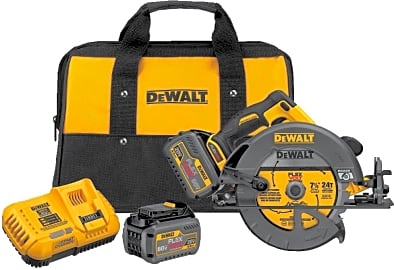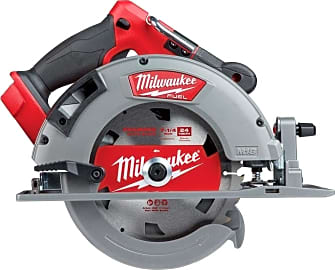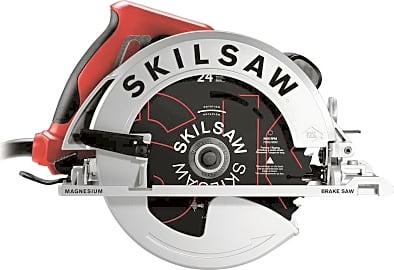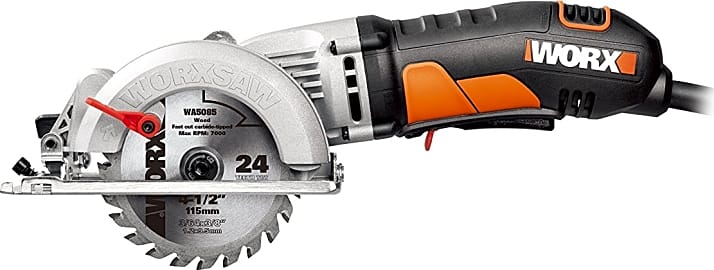The 10 Best Circular Saws

This wiki has been updated 38 times since it was first published in May of 2015. Few tools are as useful as a circular saw, whether you are a professional contractor or home DIYer. These handheld devices use either a blade or an abrasive wheel to cut through wood, aluminum, ceramic, and plenty of other materials, while modern improvements such as electronic brakes and LED lights increase safety. Whatever your budget, in this list you should find a model to suit your needs. When users buy our independently chosen editorial selections, we may earn commissions to help fund the Wiki.
Editor's Notes
November 26, 2020:
Used for making cuts in a straight line on pieces of lumber, a circular saw is an indispensable tool for a variety of trades. They not only save the user time and energy over using a regular wood saw but since they are handheld, they can easily be moved around the worksite and used on materials in situ.
In this update to the ranking, we replaced several models with their latest version. The Skilsaw Sidewinder is an inexpensive option from this reputable company and their latest iteration features an electronic brake, which makes the tool safer to use and saves time when making repeated cuts. The battery-powered Milwaukee 2730-20 was replaced with the updated Milwaukee 2732-20, and now has LED lights and an integrated dust port making it easier to follow the cutting line. Although this model doesn't come with a battery, it is compatible with batteries from any of Milwaukee's power tools, so it is a good addition to an existing toolkit. The DeWalt DWE575 is another affordable option that is notable for its lightweight construction. Its replacement, the DeWalt DWE575SB is still lightweight at only 8.8 pounds and now includes a magnetic brake that stops the blade quickly. The 57-degree bevel on the DeWalt also makes it a versatile option for angled cuts.
We removed the smaller Makita 5007MG from the list as the Makita 5008MGA is also on the list, and while both models are very similar, the latter is a safer option as it has an electric brake, and is only marginally more expensive. Instead, we decided to add the Skilsaw Sawsquatch which is a heavy-duty option that boasts a worm drive motor that is specifically designed for larger cuts and provides increased torque and durability, allowing the user to cut through multiple sheets of timber at once.
June 27, 2019:
Upon learning that the Hitachi C7ST has been discontinued by the manufacturer, we dropped it from the list. We also removed the DeWalt DWS535 due to a lack of availability. Once we found that a new version of the Skil 5680-02 existed, we swapped that in and removed the old item from the list. We highlighted its heavy-duty carbide blade and simple blade changing mechanism as positives, though we did note that some users are not satisfied with its laser guide.
With our two new additions, we purposely included a slim, linear model and a heavier traditional one to diversify the offerings. The Tacklife TCS115A is easy to operate with one hand, and it comes with several different types of blades, which makes it useful for cutting metal, plastic and tile as well as wood. The Milwaukee 2730-20 delivers impressive force for a battery-operated tool, though some folks seem to get frustrated that the wrench tends to fall out of its storage area when the saw is tilted sideways.
The decision to boost the Makita 5008MGA in the rankings was easy: its smooth electric brake is a popular feature, while users appreciate its two built-in lights and dust blower for creating a clear line of sight and keeping the workspace tidy. It’s a professional-grade model, and it’s priced accordingly.
Special Honors
Big Foot Tools Founded by Robert Hutchings, who worked as a framer and carpenter for nearly three decades, Big Foot Tools is one of the largest saw adapter companies in the world. They use the worm drive motor from the Skilsaw series and retrofitted it with a larger, stronger blade and lighter, more durable guards and footplate assembly, turning it into a highly-capable machine for everyday heavy-duty use. bigfootsaws.com
Circular Saw Types And Features
Most commonly, blades range from 5.5 inches to 7.25 inches.
Any circular saw you choose is going to come equipped with several basic features. When shopping for saws, you will see they are classified by their blade diameter. Most commonly, blades range from 5.5 inches to 7.25 inches.
The blade guard is a crucial safety feature on any circular saw. When the saw is not being used, it covers and protects the blade (and your fingers) from damage. It can be easily retracted in order to expose the blade when it is being used.
The foot plate is a base piece intended to keep the saw steady by pressing against the wood or other material while sawing. Circular saws have a depth adjustment setting that allows you to to move the foot plate so you can accommodate different thicknesses in your materials. The bevel adjustment allows the foot plate to tilt so you can make bevel cuts at the desired angle.
All circular saws are capable of making three basic cuts on wood or other materials. The first is a crosscut which simply means the saw cuts straight across a board. Rip cuts move along the length of the board. Bevel cuts refer to angled cuts that require a bit more creativity and adjustment of your saw settings.
Finally, you are going to run into two basic types of circular saws while you are shopping. The most common type is the sidewinder (or inline) circular saw. These saws have a more traditional appearance with the motor sitting on the same axis as the blade. A shaft connects the blade and motor in order to run it with precision. This type of saw can perform most tasks required from a circular saw, and they are often lightweight and easy to maneuver.
The worm drive saw is a bit heavier and more cumbersome because its motor sits at a right angle to the saw blade. Instead of a shaft, it uses gears to move the blade adding more power than a sidewinder saw. This makes it great for those heavy duty jobs.
Don't Run In Circles: Choose Right The First Time
The type of circular saw you buy is going to boil down to how you plan to use it. Aside from the basic choice between sidewinder and worm saws, you will run into options you might not have considered.
Laser guides are especially helpful because they use a light beam to show the cutting line.
First, decide if you want a cordless or corded saw. This decision will be largely based on where you plan to use your saw and what type of job lay ahead. An obvious advantage to the cordless saw is its convenience. If you are working in a tight space, the cordless circular saw might be your best bet. If you plan to use a cordless saw for your next project, try to stick to cutting wood. Some can cut other materials, but the extra power necessary can drain the battery quickly and take up more time than necessary.
Corded circular saws are more powerful because they don’t have to rely on a limited battery. They can chew through steel, masonry, and are excellent choices for those heavy duty wood cutting jobs. The biggest drawback to a corded circular saw is that you might have to purchase a compatible extension cord.
Second, don’t buy a circular saw without first checking the blade capacity. The blade capacity is the maximum depth that the blade can cut. This feature is indicated by the size of the blade. The bigger the blade, the deeper it will cut. If you have thick pieces that need to be cut, you will want to go with the larger blade. However, if precision and control are your priority, smaller blades are a better choice.
Third, electric brakes are a favorite safety feature of many circular saw users. When the user releases the trigger, the electric brakes reverse the momentum and can stop the blade in nearly two seconds. If your circular saw has this feature, it greatly improves safety.
Other important features, depending on your intended use include spindle locks, bevel capacity, bevel stops, and laser guides. All of these features improve the accuracy and quality of your cuts and improve the ease of use of your circular saw. Laser guides are especially helpful because they use a light beam to show the cutting line.
A Brief History of the Circular Saw
There is a lot of debate over who is the inventor of the first circular saw. Differing stories are told with several European countries claiming first rights. For instance, some say that Samuel Miller invented the first circular saw machine, but it is argued that he didn’t invent the blade to go with it. Others say the dutch were the first to use a circular saw in the seventeenth century.
This significantly cut down on sawing time, and the idea was eventually used in saw mills.
However, in the United States, we hear a completely different story altogether. Tabitha Babbitt was in Harvard, Massachusetts when it was rumored that she saw two men struggling to saw a log with a pit saw. She then took it upon herself to make a tin disk with notches that could be attached to and spun with her spinning wheel. This significantly cut down on sawing time, and the idea was eventually used in saw mills.
Babbitt was unable to obtain a patent due to her religion, but her invention lives on and has been improved upon over the years. York Saw Works was established in 1906 with its most popular product being the circular saw. This invention has been perfected over time and is now available in many different varieties including hand saws and table saws and is still one of the most popular tools in production today.


